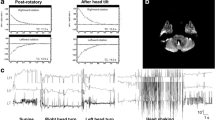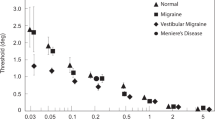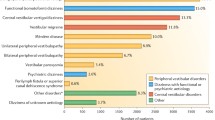Abstract
Tilt suppression refers to both tilting the head away from an Earth vertical axis and a reduction of an induced horizontal nystagmus. This phenomenon of reducing an induced horizontal nystagmus involves a circuitry of neurons within the vestibular nuclei and the cerebellum (collectively referred to as velocity storage) and signals from the otolith end organs. Lesions involving this circuitry can disrupt tilt suppression of induced horizontal nystagmus. We investigated the clinical value of combining the horizontal head-shaking nystagmus test with tilt suppression in 28 patients with unilateral peripheral vestibular hypofunction and 11 patients with lesions affecting the central nervous system. Each of the subjects with peripheral vestibular lesions generated an appropriately directed horizontal nystagmus after head shaking that then suppressed the induced angular slow phase velocity on average 52 ± 17.6% following tilt down of the head. In contrast, patients with central lesions had very little ability to suppress post-head-shaking nystagmus (mean 3.4 ± 56%). We recommend tilting the head after head shaking as a useful clinical test to assist in the differential diagnosis of vertiginous patients. In the case of unilateral peripheral vestibular hypofunction, head tilt suppresses the induced nystagmus via influence of the otolith organ. In the case of central pathology, the inability to suppress the nystagmus is from lesions impairing the otolith mediation on the velocity storage circuitry.


Similar content being viewed by others
References
Newlands SD, Vrabec JT, Purcell IM, Stewart CM, Zimmerman BE, Perachio AA (2003) Central projections of the saccular and utricular nerves in macaques. J Comp Neurol 466(1):31–47
Raphan T, Matsuo V, Cohen B (1979) Velocity storage in the vestibular-ocular reflex arc (VOR). Exp Brain Res 3:229–248
Waespe W, Cohen B, Raphan T (1985) Dynamic modification of the vestibulo-ocular reflex by the nodulus and uvula. Science 228(4696):199
Dai M, Klein A, Cohen B, Raphan T (1999) Model-based study of the human cupular time constant. Vestib Res 9(4):293–301 (PMID:10472042)
Katsarkas A, Smith H, Galiana H (2000) Head-shaking nystagmus (HSN): the theoretical explanation and the experimental proof. Acta Otolaryngol 120(2):177–181
Lee YJ, Shin EJ, Park MS, Kim JM, Na BR, Kim CH, Park HJ (2012) Comprehensive analysis of head-shaking nystagmus in patients with vestibular neuritis. Audiol Neurotol 17:228–234. doi:10.1159/000336958 (Epub 2012 Apr 5, PMID:22487934)
Kim YE, Kim JS, Yang HJ, Yun JY, Kim HJ, Ehm G, Kim JM, Jeon BS (2016) Perverted head-shaking and positional downbeat nystagmus in essential tremor. Cerebellum 15(2):152–158. doi:10.1007/s12311-015-0683-7 (PMID: 26041074)
Kim CH, Shin JE, Song CI, Yoo MH, Park HJ (2014) Vertical components of head-shaking nystagmus in vestibular neuritis, Meniere’s disease and migrainous vertigo. Clin Otolaryngol 39(5):261–265 (PMID: 25042770)
Benson AJ, Bodin CB, Bodin MA (1966) Comparison of the effect of the direction of the gravitational acceleration on post-rotational responses in yaw, pitch and roll. Aerosp Med 37(9):889–897
Han CC, Cha HE, Hwang SH (2001) Head tilt suppression test as a differential diagnostic tool in vertiginous patients. Acta Otolaryngol Suppl 545:94–96
Hain TC, Zee DS, Maria BL (1988) Tilt suppression of vestibulo-ocular reflex in patients with cerebellar lesions. Acta Otolaryngol 105(1–2):13–20 (PMID:3341153)
Lee SU, Choi JY, Kim HJ, Park JJ, Zee DS, Kim JS (2017) Impaired tilt suppression of post-rotatory nystagmus and cross-coupled head-shaking nystagmus in cerebellar lesions: image mapping study. Cerebellum 16(1):95–102. doi:10.1007/s12311-016-0772-2 (PMID: 26969184)
Solomon D, Cohen B (1994) Stimulation of the nodulus and uvula discharges velocity storage in the vestibulo-ocular reflex. Exp Brain 102:57–68
Author information
Authors and Affiliations
Corresponding author
Ethics declarations
Conflicts of interest
None of the authors have any conflict of interest to declare.
Ethical standard
The studies was approved by the local ethics committee and was performed in accordance with the ethical standards laid down in the 1964 Declaration of Helsinki.
Rights and permissions
About this article
Cite this article
Zuma e Maia, F.C., Cal, R., D’Albora, R. et al. Head-shaking tilt suppression: a clinical test to discern central from peripheral causes of vertigo. J Neurol 264, 1264–1270 (2017). https://doi.org/10.1007/s00415-017-8524-x
Received:
Revised:
Accepted:
Published:
Issue Date:
DOI: https://doi.org/10.1007/s00415-017-8524-x




